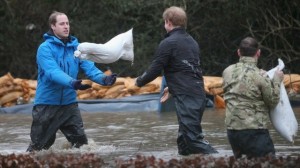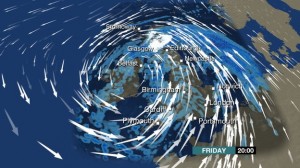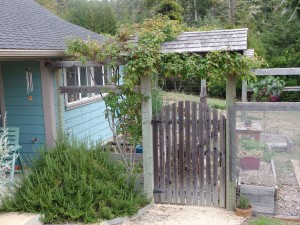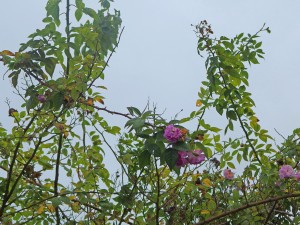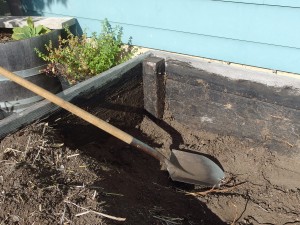Archive for the ‘history’ Category
Down by the Thames
Fifty years later, I’m startled to see the names of English villages I once knew show up on the BBC international news. Huge storms slamming the U.K. have flooded the Thames Valley west of London. I remember Datchet. My husband found his first job there when we moved from New Zealand to England in the early 1960s. On a map this area just west of Heathrow Airport shows more blue than green. The River Thames meanders through, making oxbows and loops. Manmade reservoirs, lakes and channels attempt to contain the water. The map shows the familiar stops on the railway line from London: Wraysbury, Sunnymeade, Datchet, Windsor, where we found a place to live. Today, princes William and Harry are helping to pile thousands of sandbags in Datchet. The weather map shows more floodwater coming.
What I remember most about Datchet is a cricket match. Our first summer in England, and we marveled that the sun did not set until about 10:00 pm. We were exploring the village one evening, and happened on the Datchet Cricket Club. Sunlight was golden across the grass, bathing the white flannels of the players and the trees surrounding the pitch in a romantic glow. Cricket is played in New Zealand, so we knew the game and appreciated its stately pace and formal rituals. The scene has stayed in our minds as the exemplar of the England we imagined when we left New Zealand.
Battle of the Rose Roots
I should have learned from experience. Years ago, I wondered why plants near a hedge in my Palo Alto garden weren’t doing so well, in spite of soil amendments, regular watering, and other tender loving care. Investigating closer, I found that below the soil surface was a dense mass of tiny white roots. The nourishment stealer was a Banksia rose that had flourished in the hedge for fifty years.
You would think I’d learn and remember. But no … As we designed a deer-fenced vegetable garden for our new home on the edge of the forest in Mendocino, we decided that a covered gate, an English lych-gate, would be a charming touch. And wouldn’t it be romantic to have a rose climbing over it? I’ve always been fond of “Mrs. Cecille Brunner” with its exquisite miniature pink buds.
I planted a climbing “Mrs. B” in a half wine barrel just inside the gate, out of the deer’s reach. Years passed. At a friend’s house I admired another pink climber. She told me its name, “Seven Sisters,” and offered a cutting. The local legend, she told me, was that this rose was originally brought to the Northern California coast by a Russian princess in the early 1800s. Possibly she was the well-born wife of Ivan Kuskoff, commander of the Russian American Company fur trading post at Fort Ross, whose house is still standing, and is now a National Historic Landmark. According to the story, Madame Kuskoff gave cuttings of “Seven Sisters” to friends, who gave cuttings to friends, and so it moved up the coast. I see it everywhere in the gardens of old coast homes, and have met the woman who gave my friend her cutting.
But I digress. Needless to say, my cutting of “Seven Sisters” also found a home in a wine barrel inside my fenced garden. It became a yearly task to prune these enthusiastic climbers before they totally blocked the sun from the vegetables.
This year “Seven Sisters” decided to bloom again just as I was getting out my pruning shears, so she’s still a wild tangle.
But tidy on top doesn’t mean disciplined underneath. This season I noticed that the vegetables in raised beds near the roses were stunted and sad. One scoop with the shovel showed the cause. Nothing for it but to dig out the entire bed.
There’s a layer of hardware cloth on the bottom to keep out the gophers (that’s another story). I’m hoping a couple of layers of weed cloth will deter the rose roots, at least for a few years. My friend, a Master Gardener, laughed when I told her. “You’re the eternal optimist, aren’t you?” she said.
Christchurch Earthquake
As I grieve the earthquake destruction in Christchurch, New Zealand, I have been remembering my time as a reporter on The Press, Christchurch, New Zealand’s city newspaper. I worked afternoons and evenings. When no deadlines pressed, I would gaze out my window in the Press Building, which overlooks Cathedral Square. The Press Building is badly damaged, and the cathedral spire in the center of my view has toppled. Rummaging in old files, I found fragmentary notes typed on yellowed newsprint, the small sheets we used to turn in our stories. They are undated, but would have been written in 1960 or 1961.
###
From here, with the afternoon sun through the window, people walking the square are mere silhouettes, with long shadows reaching out towards me. I can sometimes pick out what they are wearing, but they are mostly a pattern of shapes, against the curved lines of the square that isn’t a square at all, but the shape of a cross, with gently sweeping curves of the cathedral grounds in the center. A pleasant curve below me, with its little stone wall, a comfortable height for sitting on. There was a woman sitting there, by the entrance with the knobs on it. She was wearing a cream coat and a bright pink hat. It was a cheerful hat, and now her escort has arrived, and she has walked across the road with him.
Lots of people jump over the wall—it is much more fun than going through the entrance with the knobs in the proper manner.
A little choirboy runs to a bicycle parked against one of the buttresses of the cathedral. He has been to sing Evensong. Now he is joined by two others, three, four—they pour out, shouting and jostling. Neat little grey suits and red caps, schoolbags swinging in the dust. Singing is just part of their everyday living, as much as football and schoolwork.
The right of way by the cathedral is patterned with people coming to and fro. It is the back-lighting at this time of evening that makes the scene so attractive. Sunlight through the plane trees by the war memorial, a golden outline on each figure, long patterns of light and shade.
Silhouettes—the big cross on the memorial, the slender cross on the top of the cathedral spire, the stark criss-cross of the scaffolding round the spire, wrapping it in a blanket while it is cleaned and whitened. The sunlight through the green glass of the tower windows, tall narrow windows with diamond patterns.
###
Delicate tracery of bare branches outlined with sunlight on a winter afternoon. Dew silently falling—streets slowly dampen, although the sky is cloudless. Towards the west, the setting sun fills the sky with smoky pink. Buildings are grey silhouettes, slowly darkening to black. Cheerful red of transport buses the only touch of color.
###
To gather the texture of the square in the rain into a handful of feeling—dreaming out the window, with the rain spattering gently down, and the dazzling light reflected on the road, the long street lamps—white streaks, and the neon signs flashing on and off, endlessly—“Don’t be vague, ask for Haig,” and the white outline is filled up with a rush of red—“Be sure with Trufit,” hidden behind the “Choysa” oval. The “s” in Choysa is a bit wobbly—it won’t last long. The blue bird endlessly getting bigger, and then disappearing in the TEAL sign. “Fly to Australia” fades off into nothingness—it has had it too. The stars go round and round on the Monarch Shoes sign.
The colours of the neon signs are reflected in the pattern of puddles on the road—blue, purple, red, green, orange—vivid and glowing, shimmering in the circles of raindrops.
###
The gentle curve of the street below, with cars swishing round it. Not many now. It is before picture time, and only those with business at this time will be out on a night like this. An occasional bus sweeps into the stop, or lumbers out, almost empty.
The spotlight on the cathedral is smoking, as the rain hits the warm glass. The cenotaph is a black silhouette against the misty light.
Sometimes a black figure scurries across the square to the bus stop, head down, umbrella leading the way. Even the Bodgies [a youth gang] are gone from their usual haunt by the Embassy Theatre.
The King’s Speech
This weekend we saw the movie, “The King’s Speech,” that has been nominated for a slew of Oscars. Enjoyed it very much. Although the history was prettified (the British administration’s attitude toward Hitler was more ambivalent than shown), this did not detract from a moving story. I was only a toddler when King George VI made the famous war speech that climaxes the story, but I must have heard excerpts, the sound of the words was so familiar. My earliest memories are of the hush in our New Zealand home when the BBC news came on. First the stately chimes of Big Ben. Then the announcer’s voice, orotund and crackly over the long-distance airwaves: “This is London calling. Here is the news, read by …” Pictures in the newspapers of King George and Queen Elizabeth inspecting bomb damage in London and comforting the survivors. They were our king and queen, and we loved them too.
The story of “The King’s Speech” is of the future king’s terrible stammer, and of his relationship with the Australian speech therapist Lionel Logue, a World War I veteran who stayed in England after that war ended to help soldiers whose powers of speech were traumatized by their experience.
One scene hit me hard. Logue, an aspiring actor and Shakespeare enthusiast, is auditioning with a local dramatic society. Their snobbish rejection, based on his Australian accent, thrust me painfully back to the years I lived in England during the 1960s. The English class structure was rigid. My accent pigeonholed me as a colonial, a box from which I could not escape.
Whether fictional or not, the king’s loyalty to Logue the Australian, in the face of his advisors’ disapproval of the fellow’s humble origins and lack of proper credentials, endeared me further to His Majesty.
On the Haul Road
The Fort Bragg Haul Road this Saturday afternoon is like a painting of a European beach promenade. Misty silhouettes in the silvery light, family groups with dogs and bicycles take the air in the short break between storms. The sea roars. A brisk wind lifts delicate plumes of spray from the waves.
The old Haul Road is a local treasure. Built in the early 1900s to haul logs to the Fort Bragg lumber mill, it is now part of the California coastal trail system. Further north, the sea has washed away much of the road, but for close to three miles, between the Pudding Creek Trestle Bridge at the edge of town and the campground at MacKerricher State Park, it is still reasonably intact.
This afternoon, after a week of rain, people walk with smiles on their faces. The reservoirs and aquifers are filling up, ending fears of drought. More rain is forecast. Today the sky is blue and the sea magnificent.
The Storms of Yesteryear
Intermission at a Sunday afternoon concert, a knot of people take the air in the porch of Preston Hall. “That’s a beautiful sight,” a woman says, pointing to the rain sweeping in across Mendocino Bay. We are all excited. The weather gurus have warned that this rain is just precursor to a series of large storms expected to hit over the next several days.
“Remember that time we we had twenty, no forty inches of rain in one storm?” someone says.
“What about the time that rogue wave went right over the lighthouse?” Point Cabrillo Light Station, a one-story structure with a turret on top that holds a magnificent first order Fresnel lens, sits on a crumbling headland about fifty feet above the water.
“Not over the light, surely?”
“Over the roof, at least.”
Much damage?”
“Oh yes.”
I mention the first time Tony and I came to Mendocino, in 1970. In Navarro River Redwoods State Park, through which you drive to reach the coast, we were fascinated to see a plaque high up the cliff on the side of the road, marking how high the waters had come in the big flood. The date was 1965, I think. The plaque is gone now, but you can still see evidence of that flood. A whitish fungus covers the trunks of the redwood trees up to the waterline. It is particularly visible at night, illuminated by car headlights, a ghostly presence in the blackness of the forest.
The Navarro River still floods in major storms. Everyone who lives here on the coast quickly learns the alternate routes to reach inland destinations. Tree limbs fall. Mud slides. Sometimes all the roads are closed. Sometimes the power goes out for days. We learn how to hunker down. And afterward, we will have more stories.
Tongue of War
The book arrived in the mail, unexpected. Return address BkMk Press. Oh yes, I remembered, one of those poetry manuscript competitions I entered ages ago, where they send all contestants a copy of the winning book. I opened it to skim, and was immediately reading it cover to cover. Tony Barnstone’s Tongue of War: from Pearl Harbor to Nagasaki, is the most powerful anti-war testament I have ever read. I’d like to quote B.H. Fairchild, who awarded this book the John Ciardi Prize:
“…It is written in forms, especially the sonnet, and of course the meter of those forms, the pulse of human feeling unable to name itself… The diction and syntax are often blunt with the exhaustion and terror of human voices—American and Japanese, soldiers and civilians—struggling to articulate the unspeakable, to make visible that to which we have learned to blind ourselves. …I cannot help but think that having read it, an American President who has himself been privileged to avoid the horrors of the battlefield might be less inclined to send young men and women off to face them.”
